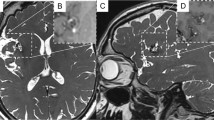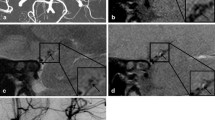Abstract
Hyperattenuating middle cerebral arteries on CT in acute stroke should generally not be associated with presence of intraluminal clot when bilaterally seen. We report a case of a woman who underwent emergency CT 60 min after sudden onset of coma. Bilateral dense middle cerebral arteries without parenchymal hypoattenuating areas or indirect signs of cerebral edema were present. CT angiography confirmed occlusion of the right middle cerebral artery and left internal carotid artery and middle cerebral artery.


Similar content being viewed by others
References
Leys D, Pruvo JP, Godefroy O, et al (1992) Prevalence and significance of hyperdense middle cerebral artery in acute stroke. Stroke 23:317–324
Petitti N (1998) The hyperdense middle cerebral artery sign. Radiology 208:687–688
Pressman BD, Tourje EJ, Thompson JR (1987) An early CT sign of ischemic infarction: increased density in a cerebral artery. Am J Roentgenol 149:582–586
Schuknecht B, Ratzka M, Hofmann E (1990) The "dense artery sign": major cerebral artery thromboembolism demonstrated by computed tomography. Neuroradiology 32:98–103
Bastianello S,Pierallini A, Colonnese C, et al (1991) Hyperdense middle cerebral artery CT sign: comparison with angiography in the acute phase of ischemic supratentorial infarction. Neuroradiology 33:207–211
Beauchamp N J, Barker PB, Wang PY, van Zijl PCM (1999) Imaging of acute cerebral ischemia. Radiology 212:307–324
New PFJ, Aronow S (1976) Attenuation measurements of whole blood and fractions in computed tomography. Radiology 121:635–640
Schuierer G, Huk W (1988) The unilateral hyperdense middle cerebral artery: an early CT-sign of embolism or thrombosis. Neuroradiology 30:120–122
Gacs C, Fox AJ, Barnett HJM, Vinuela F (1983) CT visualization of intracranial arterial thromboembolism. Stroke 14:756–762
Manelfe C, Larrue V, Von Kummer R, et al (1999) Association of hyperdense middle cerebral artery sign with clinical outcome in patients treated with tissue plasminogen activator. Stroke 30:769–772
von Kummer R, Meyding-Lamade U, Forsting M, et al (1994) Sensitivity and prognostic value of early CT in occlusion of middle cerebral artery trunk. AJNR Am J Neuroradiol 15:9–15
Rauch RA, Bazan C III, Larsson EM, Jinkins JR (1993) Hyperdense middle cerebral arteries identified on CT as a false sign of vascular occlusion. AJNR Am J Neuroradiol 14:669–673
Tomsick TA, Brott T, Barsan W, et al (1992) Thrombus localization with emergency cerebral computed tomography. AJNR Am J Neuroradiol 13:257–263
Koo CK, Teasdale E, Muir KW (2000) What constitutes a true hyperdense middle cerebral artery sign? Cerebrovasc Dis 10:419–423
von Kummer R, Meyding-Lamade U, Forsting M, et al (1994) Sensitivity and prognostic value of early CT in occlusion of middle cerebral artery trunk. AJNR Am J Neuroradiol 15:9–15
Gadda D, Vannucchi L, Niccolai F, et al (2002) CT in acute stroke: improved detection of dense intracranial arteries by varying window parameters and performing a thin-slice helical scan. Neuroradiology 44:900–906
Lev MH, Farkas J, Rodriguez VR et al (2001) CT angiography in the rapid triage of patients with hyperacute stroke to intraarterial thrombolysis: accuracy in the detection of large vessel thrombus. J Comput Assist Tomogr 25:520–528
Mattioli AV, Aquilina M, Oldani A, et al (2001) Atrial septal aneurysm as a cardioembolic source in adult patients with stroke and normal carotid arteries. A multicentre study. Eur Heart J 22:261–268
Schneider B, Hofmann T, Meinertz T (1999) Is there an association of atrial septal aneurysm with arrhythmias? Cardiology 91:87–91
Author information
Authors and Affiliations
Corresponding author
Rights and permissions
About this article
Cite this article
Gadda, D. A case of bilateral dense middle cerebral arteries with CT angiographic confirmation of vascular occlusion. Emergency Radiology 10, 142–143 (2003). https://doi.org/10.1007/s10140-003-0299-y
Received:
Accepted:
Published:
Issue Date:
DOI: https://doi.org/10.1007/s10140-003-0299-y




